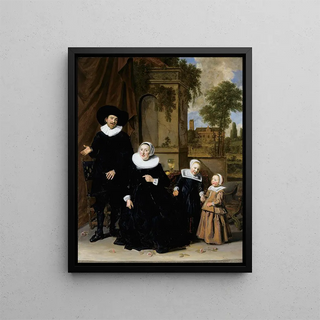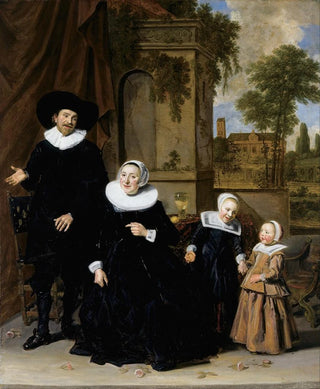Painting Portrait of a Dutch family - Frans Hals | Art print


View from behind

Frame (optional)
In the vast panorama of art history, certain works stand out for their ability to capture the very essence of an era. The "Portrait of a Dutch Family" by Frans Hals is one of those masterpieces that, through its striking realism and bold composition, transports us to the heart of 17th-century Dutch society. This iconic piece does more than depict a family; it evokes a moment of conviviality and intimacy, while offering a glimpse into the values and social dynamics of its time. The art print of this work allows for a rediscovery of the richness of Dutch painting, while highlighting Hals's unparalleled talent.
Style and uniqueness of the work
Frans Hals, an undisputed master of portraiture, is distinguished by his lively and dynamic approach. In "Portrait of a Dutch Family," he manages to infuse his subjects with a rare energy. The figures, although frozen by the painting, seem to vibrate with a palpable inner life. Hals uses bold brushstrokes and a palette of rich colors to create a warm and welcoming atmosphere. The way he plays with light and shadow accentuates the features of the characters, while giving them emotional depth. Every detail, from the draping of clothing to the expression on their faces, is carefully thought out and executed with impressive technical mastery. This painting is not merely a portrait; it is a scene of life, a snapshot of humanity that resonates through the centuries.
The artist and his influence
Frans Hals, born in Antwerp in 1582, is one of the pioneers of Dutch Baroque portraiture. His career spanned several decades, during which he evolved and adapted to the artistic changes of his time. Hals had a significant impact on portrait painting, inspiring many artists across Europe. His ability to capture the personality and individuality of his subjects paved the way for generations of painters. By incorporating elements of daily life and social interactions into his works, he succeeded in humanizing the genre of portraiture, making it accessible and relevant. The "Portrait of a Dutch Family" perfectly illustrates this approach.

Matte finish

View from behind

Frame (optional)
In the vast panorama of art history, certain works stand out for their ability to capture the very essence of an era. The "Portrait of a Dutch Family" by Frans Hals is one of those masterpieces that, through its striking realism and bold composition, transports us to the heart of 17th-century Dutch society. This iconic piece does more than depict a family; it evokes a moment of conviviality and intimacy, while offering a glimpse into the values and social dynamics of its time. The art print of this work allows for a rediscovery of the richness of Dutch painting, while highlighting Hals's unparalleled talent.
Style and uniqueness of the work
Frans Hals, an undisputed master of portraiture, is distinguished by his lively and dynamic approach. In "Portrait of a Dutch Family," he manages to infuse his subjects with a rare energy. The figures, although frozen by the painting, seem to vibrate with a palpable inner life. Hals uses bold brushstrokes and a palette of rich colors to create a warm and welcoming atmosphere. The way he plays with light and shadow accentuates the features of the characters, while giving them emotional depth. Every detail, from the draping of clothing to the expression on their faces, is carefully thought out and executed with impressive technical mastery. This painting is not merely a portrait; it is a scene of life, a snapshot of humanity that resonates through the centuries.
The artist and his influence
Frans Hals, born in Antwerp in 1582, is one of the pioneers of Dutch Baroque portraiture. His career spanned several decades, during which he evolved and adapted to the artistic changes of his time. Hals had a significant impact on portrait painting, inspiring many artists across Europe. His ability to capture the personality and individuality of his subjects paved the way for generations of painters. By incorporating elements of daily life and social interactions into his works, he succeeded in humanizing the genre of portraiture, making it accessible and relevant. The "Portrait of a Dutch Family" perfectly illustrates this approach.
12,34 €






